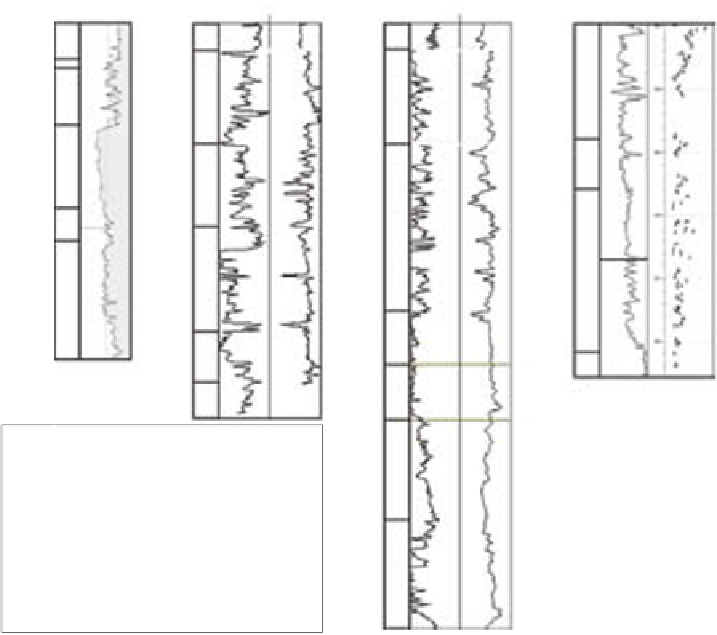Geoscience Reference
In-Depth Information
(A)
(B)
(C)
(D)
35/11-4
35/8-5 S
35/10-2 T2
34/11-A-15
Gr
Gr
Dt
Gr
Dt
Gr
Dipmeter
0
200
0
200
240 40
0
200
120
55
0
200
H
H
H
T
N
4150
3850
BN
T
T
5450
2650
E+
BN
E
N
4200
3900
2700
R
N
5500
E+
BN
R
O
3950
4250
2750
BN
R
D
E
4000
H
T
N
BN
E
E+ BN
R
D
O
Heather Fm.
Tarbert Fm.
Ness Fm.
Base Ness unit
Etive Fm.
Etive Fm. + Base Ness unit
Rannoch Fm.
Drake Fm.
Oseberg Fm.
R
4300
D
4350
Fig. 10.
Base Ness sandstone unit shown in selected well logs as a supplement to Fig. 9. Note that well 34/11-A-15 also
shows dipmeter data from the Formation Micro Image log with the tadpoles directed generally southward (down-page) in
the base Ness sandstone unit.
The local occurrence of these units (Fig. 8) with a
thick stack of tidal dunes favours interpretation as
local depocentres that experienced considerable
accommodation space generation, formed during
the initial stages of the early rift-phase. The initial
rift-stage is characterised by fault population evolv-
ing into fault-linkage and fault-death (Gawthorpe &
Leeder, 2000; Fig. 3). The stratigraphic occurrence
of these local depocentres at the base of the wedge-
shaped Ness and Tarbert formations (Figs 4 and 8)
suggests that rift-initiation occurred at this strati-
graphic level in the study area. A tidal influence has
been recorded in the Rannoch Formation (Table 2)
but tidal processes appear to have been suppressed
by wave activity. The recognition of tidal influence
in the deltaic intervals makes the suggested estua-
rine interpretation of these units probable, as tidal
currents may have been amplified landward and
not suppressed by other processes.
An alternative, non-tectonic interpretation of
these thick sandstone units is to view them as
distributary channels that were subjected to rapid
sea-level rise. Such an interpretation is possible (as
dunes are common within channels) but the strong
tidal character of the sandstones and the occurrence
of palynomorphs would be unusual within fluvial
distributary channels due to the winnowing nature
of these uni-directional high-energy environments.
Interpreting these units as an aggrading backshore
unit would contradict their local occurrence as
shown in Figs 4 and 8. The stratigraphic occurrence
at the base of the stratal wedge makes a tectonic
influence during deposition a more likely scenario.
Coastal morphology - progradational part
The pinch-out morphology of the 'Brent delta' in
Early Bajocian time has usually been interpreted to
map as a linear E-W coastline (Olsen & Steel, 1995;
Løseth
et al.
, 2009; Mjøs
et al.
, 2009). However, as
indicated in Figs 4 and 5, the Permo-Triassic faults
seem to have been active at that time. Active faults
will affect the palaeogeography of the coastline in
the sense that hangingwall areas generally show a


Search WWH ::

Custom Search